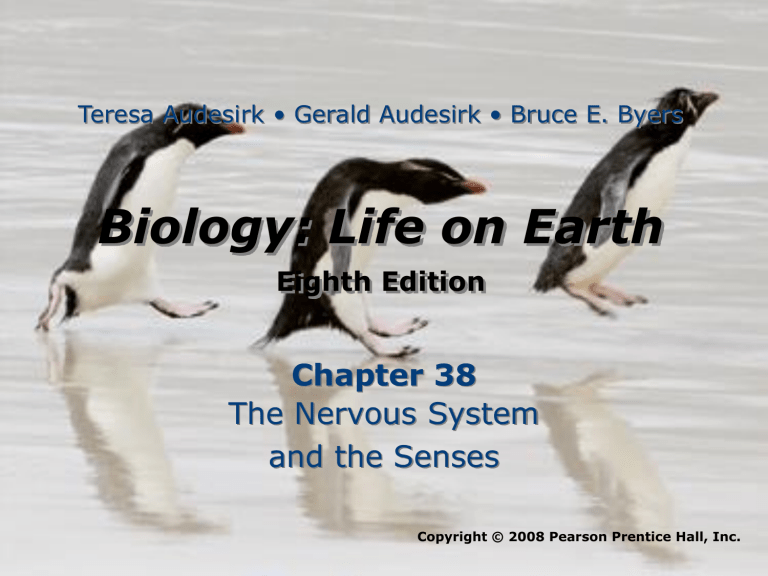
Teresa Audesirk • Gerald Audesirk • Bruce E. Byers
Biology: Life on Earth
Eighth Edition
Chapter 38
The Nervous System
and the Senses
Copyright © 2008 Pearson Prentice Hall, Inc.
Chapter 38 Opener Biology: Life on Earth 8/e ©2008 Pearson Prentice Hall, Inc.
1 Synaptic terminals:
Bring signals from
other neurons.
2 Dendrites:
Receive signals
from other neurons.
3 Cell body:
Integrates signals;
coordinates
metabolic activities.
4 Action potential
starts here.
synaptic
terminal
5 Axon: Conducts
the action potential.
dendrite
synapse
6 Synaptic terminals:
Transmit signals to
other neurons.
7 Dendrites
(of other neurons).
Figure 38-1 Biology: Life on Earth 8/e ©2008 Pearson Prentice Hall, Inc.
4
potential
(millivolts)
action potential
resting
potential
threshold
3
1
2
more
negative
less
negative
time
(milliseconds)
Figure 38-2 Biology: Life on Earth 8/e ©2008 Pearson Prentice Hall, Inc.
5
axon
node
axon
myelin
nucleus
myelin-forming
cell
myelin sheath
Figure 38-3 Biology: Life on Earth 8/e ©2008 Pearson Prentice Hall, Inc.
synaptic
terminal
1 An action potential
is initiated.
synaptic
vesicle
2 The action potential
reaches the synaptic
terminal of the
presynaptic neuron.
3 Synaptic
vesicles release
neurotransmitter.
gap
neurotransmitter
4 Receptor binds
neurotransmitter.
dendrite of
postsynaptic
neuron
Figure 38-4 (part 1) Biology: Life on Earth 8/e ©2008 Pearson Prentice Hall, Inc.
6 Neurotransmitter
taken into synaptic
terminal or degraded.
5 Postsynapitic potentials
are produced in dendtrite.
potential
(millivolts)
threshold
resting
potential
EPSP
IPSP
time
(milliseconds)
Figure 38-4 (part 2) Biology: Life on Earth 8/e ©2008 Pearson Prentice Hall, Inc.
(extracellular fluid)
Na+
Cl–
Na+
Cl–
K+
Na+
Cl–
Cl–
Na+
K+
Org–
Org–
K+
K+
Org–
Org–
(neuron cytoplasm; negatively charged)
Figure E38-1 Biology: Life on Earth 8/e ©2008 Pearson Prentice Hall, Inc.
Org–
K+
action potential starts
(extracellular fluid)
Na+
resting potential restored
Cl–
Cl–
K+
Na+
K+
Na+
K+
Org–
1
K+
K+
K+
Na+
Na+
Na+
Na+
Na+
K+
K+
(neuron cytoplasm
becomes positively
charged)
Org–
Org–
2
Na+
K+
Cl–
K+
Org–
(neuron cytoplasm becomes
negatively charged again)
Figure E38-2 Biology: Life on Earth 8/e ©2008 Pearson Prentice Hall, Inc.
Na+ action potential
(axon)
(extracellular fluid)
Figure E38-3 Biology: Life on Earth 8/e ©2008 Pearson Prentice Hall, Inc.
Na+ action potential
(axon)
K+
Figure E38-4 Biology: Life on Earth 8/e ©2008 Pearson Prentice Hall, Inc.
(extracellular fluid)
excitatory
neurotransmitter
closed receptor/
ion channel
Na+
Na+
Na+
Na+
transmitter binding
opens channel
permeable to Na+;
Na+ enters cell
Figure E38-5 (part 1) Biology: Life on Earth 8/e ©2008 Pearson Prentice Hall, Inc.
inhibitory
neurotransmitter
K+
K+
K+
K+
transmitter binding opens channel
permeable to K+; K+ leaves cell
Figure E38-5 (part 2) Biology: Life on Earth 8/e ©2008 Pearson Prentice Hall, Inc.
Table 38-1 Biology: Life on Earth 8/e ©2008 Pearson Prentice Hall, Inc.
(a) Gentle touch
1
fires slowly
2
silent
(b) Moderate pressure
1
fires more rapidly
2
(c) Strong pressure
silent
1
fires very rapidly
2
fires slowly
Figure 38-5 Biology: Life on Earth 8/e ©2008 Pearson Prentice Hall, Inc.
Figure E38-6 Biology: Life on Earth 8/e ©2008 Pearson Prentice Hall, Inc.
ring of ganglia
brain
nerve cords
diffuse network
of neurons
(a) Hydra
cerebral
ganglia
(brain)
(b) Flatworm
Figure 38-6 Biology: Life on Earth 8/e ©2008 Pearson Prentice Hall, Inc.
(c) Octopus
The Nervous System
Central Nervous System (CNS)
Peripheral Nervous System (PNS)
receives and processes information;
initiates action
transmits signals between the CNS
and the rest of the body
Brain
Spinal Cord
Motor Neurons
Sensory Neurons
receives and processes
sensory information;
initiates responses;
stores memories;
generates thoughts
and emotions
conducts signals to and
from the brain; controls
reflex activities
carry signals from the
CNS that control the
activities of muscles
and glands
carry signals to
the CNS from
sensory organs
Somatic Nervous System
controls voluntary
movements by activating
skeletal muscles
Autonomic Nervous System
controls involuntary responses
by influencing organs, glands,
and smooth muscle
Sympathetic Division
prepares the body for
stressful or energetic
activity; "fight or flight"
Figure 38-7 Biology: Life on Earth 8/e ©2008 Pearson Prentice Hall, Inc.
Parasympathetic Division
dominates during times of
"rest and rumination";
directs maintenance activities
Parasympathetic
Sympathetic
eye
salivary and
lacrimal glands
cranial
cranial
lungs
cervical
cervical
heart
liver
thoracic
pancreas
thoracic
kidney stomach
kidney
spleen
lumbar
small
intestine large
intestine
lumbar
rectum
sacral
urinary
bladder
uterus
external
genitalia
sacral
sympathetic
ganglia
Figure 38-8 Biology: Life on Earth 8/e ©2008 Pearson Prentice Hall, Inc.
white matter
contains
myelinated
axons
central canal
contains
cerebrospinal fluid
peripheral nerve
gray matter
contains cell
bodies of motor
neurons and
interneurons
dorsal root
contains axons
of sensory
neurons
dorsal root
ganglion
contains cell
bodies of
sensory neurons
peripheral nerve
ventral root
contains axons of
motor neurons
Figure 38-9 Biology: Life on Earth 8/e ©2008 Pearson Prentice Hall, Inc.
1 A painful
stimulus activates
a pain receptor.
2 Signal transmitted
by a pain sensory neuron.
stimulus
receptor
dorsal
root
sensation
relayed
to the brain
REFLEX
ARC
5 Effector muscle
causes withdrawal effector
response.
ventral
root
4 Motor neuron
stimulates the
effector muscle.
Figure 38-10 Biology: Life on Earth 8/e ©2008 Pearson Prentice Hall, Inc.
3 Signal transmitted
to a motor neuron by an
interneuron within the
spinal cord.
(a)
(c)
optic lobe
thalamus
cerebrum
cerebellum
cerebrum
midbrain
cerebellum
medulla
forebrain midbrain hindbrain
EMBRYONIC VERTEBRATE BRAIN
cerebrum midbrain
cerebellum
(b)
GOOSE BRAIN
(d)
cerebrum
SHARK BRAIN
midbrain
(inside)
cerebellum
HUMAN BRAIN
Figure 38-11 Biology: Life on Earth 8/e ©2008 Pearson Prentice Hall, Inc.
meninges
craneo
Corteza
cerebral
Cuerpo
calloso
hipotalamo
talamo
Glandula
pituitaria
Glandula
pineal
mesecefalo
cerebelo
rombencef
Varolio
Bulbo raquideo
spinal cord
Figure 38-12 Biology: Life on Earth 8/e ©2008 Pearson Prentice Hall, Inc.
limbic region
of cortex
cerebral cortex
corpus callosum
thalamus
hypothalamus
amygdala
Figure 38-13 Biology: Life on Earth 8/e ©2008 Pearson Prentice Hall, Inc.
hippocampus
primary
sensory area
Frontal
Lobe
primary
motor area
premotor
area
higher
intellectual
functions
leg
trunk
arm
hand
Parietal
Lobe
sensory
association
area
face
speech
motor area
tongue
primary
auditory
auditory association
area
area: language
comprehension
memory
Temporal
Lobe
Figure 38-14 Biology: Life on Earth 8/e ©2008 Pearson Prentice Hall, Inc.
visual
association
area
primary
visual
area
Occipital
Lobe
Left
HEART
Right
LEFT HEMISPHERE
1. Controls right side
of body
2. Input from right
visual field, right ear,
left nostril
3. Centers for language,
speech, reading,
mathematics, logic
RIGHT HEMISPHERE
1. Controls left side
of body
2. Input from left
visual field, left
ear, right nostril
3. Centers for spatial
perception, music,
creativity, recognition
of faces and
emotions
retina
optic nerve
optic chiasma
corpus callosum
visual cortex
Figure 38-15 Biology: Life on Earth 8/e ©2008 Pearson Prentice Hall, Inc.
Hearing Words
Seeing Words
Reading Words
Generating Verbs
0
Figure E38-7 Biology: Life on Earth 8/e ©2008 Pearson Prentice Hall, Inc.
max
Figure E38-8a Biology: Life on Earth 8/e ©2008 Pearson Prentice Hall, Inc.
Figure E38-8b Biology: Life on Earth 8/e ©2008 Pearson Prentice Hall, Inc.
Figure 38-16 Biology: Life on Earth 8/e ©2008 Pearson Prentice Hall, Inc.
Table 38-2 Biology: Life on Earth 8/e ©2008 Pearson Prentice Hall, Inc.
free nerve endings
(touch, pain, or
temperature)
Merkel’s disc
(steady touch)
epidermis
sebaceous
(oil) gland
hair endorgan (hair
movement)
dermis
hair
root
subcutaneous
tissue
Ruffini’s endorgan (pressure)
Meissner’s corpuscle
(light touch, rapid
movement)
Pacinian
corpuscle
(rapid movement)
Figure 38-17 Biology: Life on Earth 8/e ©2008 Pearson Prentice Hall, Inc.
(a)
Outer ear
Middle ear
bones of
middle ear
pinna
Inner ear
vestibular system
(detects head
movement
and gravity)
auditory nerve
to brain
cochlea
auditory
canal
tectorial
membrane
tympanic
membrane round
to
oval window
pharynx
auditory
window
tube
(beneath
(Eustachian tube)
stirrup)
(c)
(b)
bony
cochlear
wall
tectorial
membrane
hair
cell
basilar membrane
hair
cells
axons of
auditory
nerve
Figure 38-18 Biology: Life on Earth 8/e ©2008 Pearson Prentice Hall, Inc.
auditory
nerve
basilar
membrane
hair cells
scar
Figure 38-19a Biology: Life on Earth 8/e ©2008 Pearson Prentice Hall, Inc.
X hours before hearing can be damaged
loudness range
jet takeoff
(at 200 ft)
rock concert
subway, stereo headphones
(high volume)
motorcycle, lawn mower
urban street
normal talking
quiet
background
decibels
Figure 38-19b Biology: Life on Earth 8/e ©2008 Pearson Prentice Hall, Inc.
2
8
1/4
Compound eyes
Figure 38-20a Biology: Life on Earth 8/e ©2008 Pearson Prentice Hall, Inc.
Ommatidia
Single ommatidium
lenses
pigmented
cells
receptor
cells
Figure 38-20b Biology: Life on Earth 8/e ©2008 Pearson Prentice Hall, Inc.
Anatomy of the human eye
sclera
ligaments
choroid
retina
fovea
iris
vitreous
humor
blood
vessels
eyelash
lens
pupil
cornea
optic
nerve
blind spot
Figure 38-21a Biology: Life on Earth 8/e ©2008 Pearson Prentice Hall, Inc.
aqueous
humor
lens
muscle
Layers of the retina
(photoreceptors)
rods
cones
axons form
ganglion cell
optic nerve
light
signal-processing
neurons
membrane discs
bearing
photopigment molecules
Figure 38-21b Biology: Life on Earth 8/e ©2008 Pearson Prentice Hall, Inc.
ganglion
cell
(a) Normal
eye
(b) Nearsighted
eye
(c) Farsighted
eye
retina
Distant object,
lens thins to
focus on retina.
Distant object
focused in front
of retina.
Close object
focused
behind retina.
Figure 38-22 Biology: Life on Earth 8/e ©2008 Pearson Prentice Hall, Inc.
Close object, lens
fattens to focus
on retina.
Concave lens diverges
rays, object focused on
retina.
Convex lens converges
rays, object focused
on retina.
blind
spot
fovea
Figure 38-23 Biology: Life on Earth 8/e ©2008 Pearson Prentice Hall, Inc.
Figure 38-24 Biology: Life on Earth 8/e ©2008 Pearson Prentice Hall, Inc.
Figure 38-25a Biology: Life on Earth 8/e ©2008 Pearson Prentice Hall, Inc.
Figure 38-25b Biology: Life on Earth 8/e ©2008 Pearson Prentice Hall, Inc.
olfactory
epithelium
olfactory structure of brain
nasal
cavity
bone
olfactory
receptors
mucus
layer
air with
odor molecules
nasal cavity
Figure 38-26 Biology: Life on Earth 8/e ©2008 Pearson Prentice Hall, Inc.
olfactory
dendrites
The human tongue
papillae
Figure 38-27a Biology: Life on Earth 8/e ©2008 Pearson Prentice Hall, Inc.
Taste bud
microvilli
taste pore
epithelium
of tongue
taste
receptor
cells
Figure 38-27b Biology: Life on Earth 8/e ©2008 Pearson Prentice Hall, Inc.
supporting
cells
nerve
fibers
to brain
injury
Blood proteins
are released
by damaged
capillary.
K+ and enzymes
are released by
cell damage.
capillary
Figure 38-28 Biology: Life on Earth 8/e ©2008 Pearson Prentice Hall, Inc.
pain
receptor
neuron
Figure 38-29a Biology: Life on Earth 8/e ©2008 Pearson Prentice Hall, Inc.
Figure 38-29b Biology: Life on Earth 8/e ©2008 Pearson Prentice Hall, Inc.
Figure 38-30a Biology: Life on Earth 8/e ©2008 Pearson Prentice Hall, Inc.
nonconducting
object
electric field
electric
organ
electroreceptors
Figure 38-30b Biology: Life on Earth 8/e ©2008 Pearson Prentice Hall, Inc.






